Luxury brand advertising: stronger visuals, fewer words
14 Feb 2013
The luxury market has been on the upswing for many years now. And India is second only to Hong Kong in the growth of the luxury consumer segment. By 2015, a quarter of the global luxury market will be in India and China.
It's a general belief that luxury items are a marker of fashion, a status symbol, a barometer of success and power; which is why luxury brands typically appeal to the aspirational and emotional side of consumers.
But how are luxury brands made to appear desirable? And what helps create exclusivity around them?
Luxury brands need to be in the immediate consideration of a set of buyers. It has been shown that while the penetration levels of luxury brands may be very low, awareness levels need to be significantly high. Advertising plays a key role in fulfilling this objective.
In India, the major ad spend by luxury brands is allocated to print media - primarily because it is a better targeted medium to reach the right audience.Ads account for 41 per cent of the total content of premium or luxury magazines like Vogue, Verve, Time N Style, GQ, Harper's Bazaar, MW and Cosmopolitan, according to our study.
Mass magazines like India Today, Outlook, Business World, The Week, etc, carry approximately 26 per cent of their total printed content as advertisements, according to the study.
Our team decided to delve deep into leading upmarket magazines carrying advertising for luxury brands to unearth key trends and semiotic codes of luxury advertising in India. The team analysed 511 advertisements in leading luxury magazines including those mentioned above.
All the ads were mapped quantitatively on various parameters. Additionally, a qualitative analysis was done along with a few expert interviews to arrive at some key lessons.
Composition of ads
Personal adornment brands feature in the maximum number of ads in the magazines under study. Products which do not directly enhance personality are advertised far less.
For example: apparel and watches, which are a direct gateway to 'status elevation' in promotion speak, have the highest number of ads. Categories like real estate, home furnishing, hospitality, etc are lower.
Ad break-up
The composition of ads in various categories:
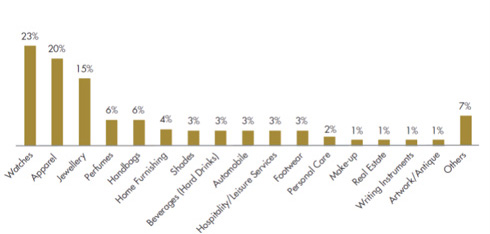
Paradoxes of luxury advertising
Luxury Brands are going local while mainstream Indian brands are going international.
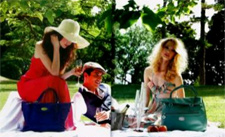 Interestingly a lot of Indian brands are trying to project an international image by using international models in their ads. Approximately 14 per cent of Indian brands surveyed have used foreign models in their advertisements.
Interestingly a lot of Indian brands are trying to project an international image by using international models in their ads. Approximately 14 per cent of Indian brands surveyed have used foreign models in their advertisements.
Conversely, international brands are addressing Indian sensibilities by catering to Indian tastes and requirements. Canali launched a 'bandhgala' (a closed neck 'Nehru' jacket), lending the essential Indian look an international pedigree. Even Lladro's line-up of famous figurines now features Indian gods and goddesses.
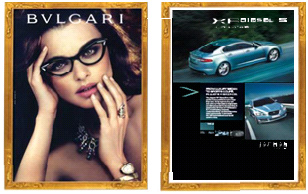 An interesting finding of the analysis of all the luxury brand ads reveals that most of the brands advertised in the magazines have no body copy. Some 60 per cent of the ads analysed did not have any copy. They featured only visuals and the brand name.
An interesting finding of the analysis of all the luxury brand ads reveals that most of the brands advertised in the magazines have no body copy. Some 60 per cent of the ads analysed did not have any copy. They featured only visuals and the brand name.
The visuals along with just the brand name define the personality of the brand. For consumers well versed with the 'personality' of the brand, the name is enough and for the uninitiated, sharp visuals work in attracting them.
 Luxury brands are the signifiers of higher levels of the social ladder. Hence, they create a larger than life imagery through sharp visuals and photography. Contrast this with mass brands that feature extensive body copy in their advertising to justify a purchase.
Luxury brands are the signifiers of higher levels of the social ladder. Hence, they create a larger than life imagery through sharp visuals and photography. Contrast this with mass brands that feature extensive body copy in their advertising to justify a purchase.
From the consumer's point of view the financial investment in luxury brands is far higher than mass brands and the justification from the seller's point of view is correspondingly far lesser. In other words mass brands' advertising sells, Luxury brands' advertising evokes desire.
Our further analysis revealed that primarily there are 6 key tenets that form the basis of most luxury brand advertising. These 6 codes are:
- The two-tone code
- The exclusivity code
- The sensuality code
- The craftsmanship code
- The origin code
- The heritage code
The two-tone code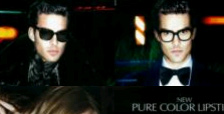 Dark shades of black, purple, red, etc are the common colours used in luxury advertising. Such colours are used because they connote luxury. Only a few ads use lighter shades in their advertising. In contrast, ads of mass brands use lighter shades in their advertising.
Dark shades of black, purple, red, etc are the common colours used in luxury advertising. Such colours are used because they connote luxury. Only a few ads use lighter shades in their advertising. In contrast, ads of mass brands use lighter shades in their advertising.
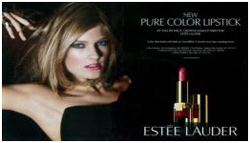 Going further, the logos of luxury brands are primarily in black or white. In our analysis of 511 ads, 66 per cent of brands that were advertised had black/white logo.
Going further, the logos of luxury brands are primarily in black or white. In our analysis of 511 ads, 66 per cent of brands that were advertised had black/white logo.
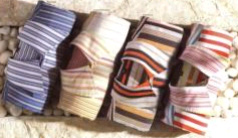 On the other hand, in the case of mainstream Indian brands, logos do not necessarily follow a black and white pattern.
On the other hand, in the case of mainstream Indian brands, logos do not necessarily follow a black and white pattern.
The sensuality code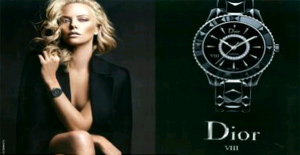 It can be observed that advertising for luxury brands is much more sensual than mass brands. Probably it is one of the ways to create a desirable personality and distance luxury brands from others brands. From perfumes to handbags to watches, sensuality is an integral part of luxury advertising.
It can be observed that advertising for luxury brands is much more sensual than mass brands. Probably it is one of the ways to create a desirable personality and distance luxury brands from others brands. From perfumes to handbags to watches, sensuality is an integral part of luxury advertising.
Mass Indian brands keep to the basic tenets of visual appeal intact; however they do not go a step further to evoke sensuality.
The exclusivity code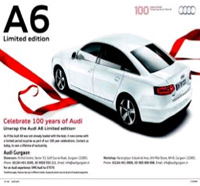 Another way of enhancing the luxury quotient is by creating an expression of exclusivity. Luxury brands try and create an aura of uniqueness since it gives an assurance of being owned only by select people. Overabundance and easy availability of a luxury brand can cause dilution of its luxury character; hence many brands try to maintain the perception that the goods are scarce.
Another way of enhancing the luxury quotient is by creating an expression of exclusivity. Luxury brands try and create an aura of uniqueness since it gives an assurance of being owned only by select people. Overabundance and easy availability of a luxury brand can cause dilution of its luxury character; hence many brands try to maintain the perception that the goods are scarce.
Exclusivity is brought about in two ways: first, by introducing 'limited edition' products.
The other way is by making them available at limited locations where the product can be brought. By mentioning the exclusive outlets/flagship stores, brands make sure that consumers know where they are available, as well as signify their presence in India.
The craftsmanship code
Luxury brand advertising lays more emphasis on the craftsmanship and intricate mechanisms involved in the product. For example, an apparel ad shows the cut and fabric up close or a watch ad shows the mechanisms inside the watch.
Some luxury brands elucidate the luxury quotient of their brand by mentioning the country of origin of the brand.
Going ahead, luxury marketers are taking a step further and using the city of origin to bring more credibility to the brand.
The heritage code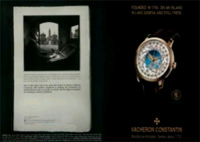 Heritage of a brand builds an aura of several years of excellence in providing luxury products. It exemplifies the years of mastery or lineage to add a mystique to the brand.
Heritage of a brand builds an aura of several years of excellence in providing luxury products. It exemplifies the years of mastery or lineage to add a mystique to the brand.
A mystique is generally built around the exceptional legendary founder of the past, making up an integral part of the brand story and brand personality.
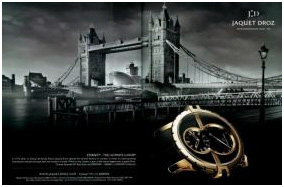 So when consumers buy a Cartier or a Chanel product it is not only because of the product performance factor, but subconsciously they are also influenced by the brand's rich lineage and heritage.
So when consumers buy a Cartier or a Chanel product it is not only because of the product performance factor, but subconsciously they are also influenced by the brand's rich lineage and heritage.
Indian brands adopt 'the luxury code' to build their franchise.
Increasingly the non-luxury Indian brands are following the codes of luxury marketing in their advertising to up their premium quotient and include themselves in the category of luxury brands.
The gap between Indian brands and international luxury brands will tend to narrow as Indian brands acquire prestige, improve their quality quotient and adopt luxury codes.
Summary
In the case of luxury brand advertising, the main driver is the brand name itself. Visuals play an important role to create and aura and mystique. It involves a careful selection of international models, dark colours, minimal body copy, etc, as mentioned above.
Along with elevating the social status, a brand needs to evoke strong emotional reactions in order to signify luxury. These emotional reactions can be brought alive by adopting one or a combination of the luxury codes.
The advertisements that appear in this article are as published by the brand owner/company in papers and publications available in the public domain. These have been included in the article only for representation and to clarify the context of the content in this article. The advertisements, logos and brand names that appear in this article are the property of the organisations concerned. The author's agency has not been involved directly or indirectly in the creation of any of the advertisements appearing here.













.jpg)






.jpg)









